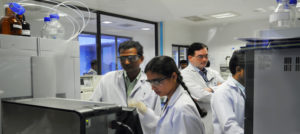 In a post last month, we discussed the three types of peptide production techniques Neuland uses to cGMP manufacture peptide APIs and NCEs for clients. We also mentioned some of the attendant advantages and disadvantages that had prevented them from reaching their full commercial potential as therapeutic agents. I wanted to expand a bit on that, since the science of peptides is quickly progressing…rendering some disadvantages moot while others – not previously considered – emerge.
In a post last month, we discussed the three types of peptide production techniques Neuland uses to cGMP manufacture peptide APIs and NCEs for clients. We also mentioned some of the attendant advantages and disadvantages that had prevented them from reaching their full commercial potential as therapeutic agents. I wanted to expand a bit on that, since the science of peptides is quickly progressing…rendering some disadvantages moot while others – not previously considered – emerge.
As I’ve mentioned before, the promise of peptides generally exceeded the reality – or at least the science – of peptide-derived therapeutics. The list of barriers to entry have always seemed formidable:
- high production cost & infrastructure requirements
- rapid degradation profiles in the human body
- corresponding lack of oral dosing delivery mechanisms
- other pharmacodynamic limitations (short half-life, high hydrophilicity, rapid hepatic clearance, etc.)
These challenges all conspired to render the peptide class promising – but ultimately unrealizable.
It’s a far cry from the early days of pharma, when peptide-based compounds like penicillin, cyclosporine, and insulin first rose to prominence. Fast forward several decades – what exactly has changed to make peptides suddenly attractive as a therapeutic class?
Peptides: A Strong – but Difficult – Class
With regard to peptides themselves, very little has changed: they have long been (and still are) well-regarded as safe, efficacious and highly-selective. According to a January 2015 article in Drug Discovery Today:
“More than 7000 naturally occurring peptides have been identified, and these often have crucial roles in human physiology, including actions as hormones, neurotransmitters, growth factors, ion channel ligands, or anti-infectives. In general, peptides are selective and efficacious signaling molecules that bind to specific cell surface receptors.”
Compared with proteins and antibodies, peptides have the potential to penetrate further into tissues owing to their smaller size. Moreover, therapeutic peptides, even synthetic ones, are generally less immunogenic than recombinant proteins and antibodies.
What has changed is that we’ve finally arrived at a point at which science can begin to overcome the challenges of economical peptide production and effective therapeutic delivery routes.
Multiple, Converging Advances Driving Peptide Therapeutic Potential
The changes have come about due to a collection of advances in chemistry, biology, genomics, dosage formulation, combined with rapid shifts in our understanding of human health and exponential improvements in technology (from computational power & informatics to spectrometry, imaging and more).
Over the last two decades, we’ve seen sufficient advances in these different but interrelated areas begin to converge, enabling not a rethinking of peptides but rather the realization of their known benefits & potential.
These developments fall into three (very) broad categories:
- Synthetic Chemistry
The emergence of synthetic peptide production offers significant advantages over more costly recombinant techniques, including a much wider diversity of chemical peptides and far more economical production. The use of SPPS to produce larger, more complex peptides – in tandem with hybrid techniques that combine solution phase and solid phase methods – has broadened the landscape of peptide opportunities considerably.
- Peptide Development & Drug Delivery
Peptide design complexity has also increased: developments in peptide drug conjugates, peptidomimetics and more have improved peptide degradation profiles and extended bioavailability – enabling a wider range of delivery options. Chemistry advances have also played a key role, and the chemical structure of peptides is often optimized for therapeutic use (e.g., replacing peptide bonds).
Developments in the broader field of drug delivery have come into play with peptide-based therapeutics, as well. This includes alternate routes of administration being improved or developed. Peptides are lending themselves well to controlled release techniques, and exploration of non-parenteral dosing continues to expand and demonstrate viability.
A number of strategies to extend bioavailability have been successfully deployed, including:
- Mucosal: use of nasal sprays and sublingual use
- Oral: coatings are used to protect the active substance from digestion in the stomach, or to protect the peptide against peptidases
- Transdermal: patches have been successfully developed
- Commercial Peptide Manufacturing
Peptide manufacturing – as I mentioned last month in this post – has become much more cost-efficient and capable, especially since the emergence of synthetic peptides. The push continues: peptides will continue to get larger, and cost efficiencies will continue to improve.
Peptides as a rising therapeutic option are an excellent example of the slow, ponderous shift of science and technology. It was common in the early 2000s to point to a single type of science – genomics, for example, or proteomics, or informatics – and proclaim each one as the key paradigm shifter. None of them, alone, ever lived up to the hype as ‘The Science That Would Change Everything.’ But I would argue that each one has contributed to our general understanding – unlocking the next door, and opening up new opportunities.
Peptides are an excellent example of that in practice, with a growing number currently in clinical trials to treat a range of oncological, metabolic, cardiovascular and other conditions and infectious diseases.










